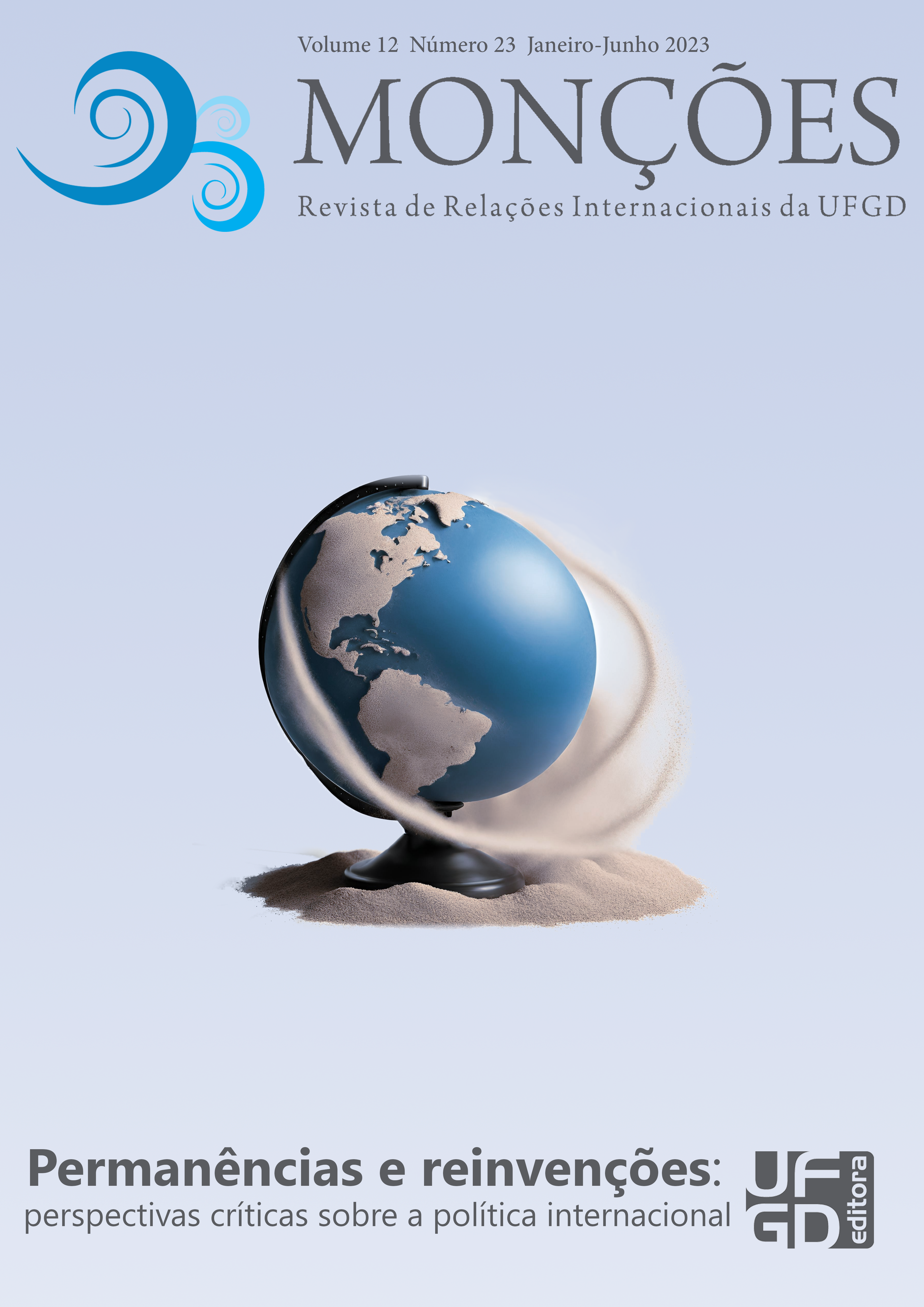Multiple facets of international security in the post-Second World War period: the law-based project, economical interrelationships and the nuclear balance of terror
DOI:
https://doi.org/10.30612/rmufgd.v12i23.15156Keywords:
International security, Second World War, Cold WarAbstract
This paper aims at depicting international security projects in the two decades following World War II as a multilayered setup, comprising three streams: (i) in the UN, the legally informed project of collective security; (ii) in multiple institutional arenas, initiatives with an emphasis on entanglements between economic issues, domestic stability and international security; and (iii) nuclear deterrence, based on the configuration of the scenario of mutually assured destruction as the Cold War intensified. The research method used is qualitative in nature, based upon bibliographic investigation, and proceeds through historical characterization of aspects related to international security in the defined period. The theoretical starting point is John Ikenberry's depiction of the period as comprising a multilayered institutional order. The contribution presented consists in evidencing there was neither a single project nor a single front for international security in the period, but rather a multifaceted and dynamic scenario, having undergone transformations in the analyzed period and being supported by diverse conceptions which encompassed: legally informed conceptions of collective security, the emphasis on connections between economic and security issues, and the balance of terror, the rationality of which was informed by the realist approach to international relations theory.Downloads
References
BALASSA, Bela. Towards a theory of economic integration. Kyklos, v. 14, n. 1, p. 1–17, 1961.
BARRAL, Welber de O. O comércio internacional. Belo Horizonte: Del Rey, 2007.
BLACK, Lloyd D. A estratégia da ajuda externa. Rio de Janeiro: O Cruzeiro, 1968.
CARR, Edward. H. The twenty years’ crisis 1919-1939: an introduction to the study of international relations. London: Macmillan & Co., 1946.
CASTRO, Marcus. F. de. Instituições econômicas: Evolução de seus elementos constitucionais na sociedade de mercado. Revista de Direito Empresarial, v. 6, p. 41–62, 2006.
CASTRO, Marcus. F. de. Política e relações internacionais: fundamentos clássicos. Brasília: Editora UnB, 2005a.
CASTRO, Marcus. F. de. Violência, medo e confiança: Do governo misto à separação dos poderes. Revista Forense, v. 382, p. 157–180, 2005b.
CONFORTI, Benedetto. The law and practice of the United Nations. Leiden/Boston: Martinus Nijhoff Publishers, 2005.
EICHENGREEN, Barry. Globalizing capital: a history of the international monetary system. 2. ed. Princeton: Princeton University Press, 2008.
GUIMARÃES, Samuel. P. Quinhentos anos de periferia. Porto Alegre: Contraponto, 1999.
HELLEINER, Eric. States and the reemergence of global finance: from Bretton Woods to the 1990s. Ithaca: Cornell University Press, 1996.
IKENBERRY, Joh. G. After victory: institutions, strategic restraint, and the rebuilding of order after major wars. Princeton: Princeton University Press, 2001.
JACKSON, John. H. The world trading system: law and policy of international economic relations. 2. ed. Cambridge: MIT Press, 2000.
JACKSON, Scott. Prologue to the Marshall Plan: the origins of the American commitment for a European recovery program. Journal of American History, v. 65, n. 4, p. 1043–68, 1979.
KAPLAN, Morton. A.; KATZENBACH, Nicholas. B. Fundamentos políticos do direito internacional. Rio de Janeiro: Zahar, 1964.
KENNAN, George. Review of Current Trends, U.S. Foreign Policy: Report by the Policy Planning Staff PPS23, February 28, 1948. US Department of State: foreign relations of the United States: 1948, v. 1, n. 2, p. 509–29, 1976.
KETTELL, S. The political economy of exchange rate policy-making: from the gold standard to the Euro. London: Palgrave Macmillan, 2004.
KEYNES, John M. A teoria geral do emprego, do juro e da moeda. São Paulo: Nova Cultural, 1996.
KEYNES, John M. As consequências econômicas da paz. São Paulo/Brasília: Imprensa Oficial do Estado/Universidade de Brasília, 2002.
KOSKENNIEMI, Martti. The gentle civilizer of nations: The rise and fall of international law 1870 - 1960. Cambridge: Cambridge University Press, 2004.
MAZOWER, Mark. No enchanted palace: the end of empire and the ideological origins of the United Nations. Princeton: Princeton University Press, 2008.
PEREIRA, João M. M. O Banco Mundial como ator político, intelectual e financeiro (1944-2008). Niterói: Universidade Federal Fluminense, 2009. (Tese de doutorado).
POLANYI, Karl. The great transformation: the political and economic origins of our time. 2. ed. Boston: Beacon Press, 2001.
RODRIK, Dani. The globalization paradox: democracy and the future of the world economy. New York, NY: Norton, 2011.
RUGGIE, John G. International regimes, transactions, and change: embedded liberalism in the postwar economic order. International Organization, v. 36, n. 2, p. 379–415, 1982.
RUIZ MEDRANO, Salvador F. Antecedentes historico-juridicos del comercio internacional contemporaneo. Quaestio Iuris, v. 10, n. 4, p. 2637–2656, 2017.
SALIBA, Aziz. T. Conselho de segurança da ONU: sanções e limites jurídicos. Curitiba: Juruá, 2008.
SALIBA, Aziz. T.; PENA, Hugo. Retórica jurídica e poder: uma análise da campanha do Itamaraty por assento permanente no Conselho de Segurança da ONU. Sequência, v. 29, n. 57, p. 195–212, 2008.
SATO, Eiiti. Economia e política das relações internacionais. Belo Horizonte: Fino Traço, 2012.
SHEEHAN, Michael. The balance of power: history & theory. London/New York: Routledge, 2005.
STELZER, Joana. União Europeia e supranacionalidade: desafio ou realidade? 2. ed. Curitiba: Juruá, 2004.
Downloads
Published
How to Cite
Issue
Section
License
- Os autores e autoras mantêm os direitos autorais e concedem à revista o direito de primeira publicação, com o trabalho simultaneamente licenciado sob a Creative Commons Atribuição-NãoComercial-CompartilhaIgual 3.0 Brasil. que permite o compartilhamento do trabalho com reconhecimento da autoria e publicação inicial nesta revista.
- Autores e autoras têm autorização para assumir contratos adicionais separadamente, para distribuição não-exclusiva da versão do trabalho publicada nesta revista (ex.: publicar em repositório institucional ou como capítulo de livro), com reconhecimento de autoria e publicação inicial nesta revista.
- Autores e autoras têm permissão e são estimulados a publicar e distribuir seu trabalho online (ex.: em repositórios institucionais ou na sua página pessoal) a qualquer ponto antes ou durante o processo editorial, já que isso pode gerar alterações produtivas, bem como aumentar o impacto e a citação do trabalho publicado, porém invariavelmente com o reconhecimento de autoria e publicação inicial nesta revista.


